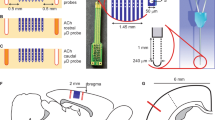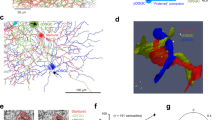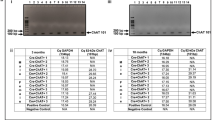Abstract
Cholinesterases in brain tissue are divided into two main classes: ‘true’ cholinesterases (acetylcholinesterase, AChE, EC 3.1.1.7), which preferentially hydrolyse the neurotransmitter acetylcholine; and ‘pseudocholinesterases’ (for example, butyrylcholinesterase, BuChE, EC 3.1.1.8), which preferentially hydrolyse higher choline esters1. AChE is found at peripheral and central cholinergic synapses, is known to be the degradative enzyme of the cholinergic mechanism and may also have other functions in the central nervous system1–3. In contrast to AChE, the pseudocholinesterases have been assigned no certain function in neural transmission and initially were thought to occur mainly in neuroglia, Schwann cells and vascular endothelia1,4. Pseudocholinesterase activity has since been found in neurones and neuropil in several brain regions1,4,5, however, and in the superior cervical ganglion, BuChE has been localized to postsynaptic membranes6 and shown to exist in stable molecular forms corresponding to each of the known molecular forms of true cholinesterase7. These observations have led to the alternative interpretations that the pseudocholinesterases are either metabolic precursors of AChE8 or that they have functions closely related to those of AChE5,7 while being independent of true cholinesterases. We have directly compared the distributions of BuChE and AChE in the central visual pathway of the primate, a neural system in which anatomical and functional compartmentalization is well known9. We demonstrate here that the histochemical localization of Pseudocholinesterase rivals that of AChE in terms of specificity, and that BuChE is independent of AChE both in its normal distribution in the lateral geniculate body and striate cortex and in the response it shows to eye enucleation. We conclude that BuChE or its endogenous substrate may be a neuroactive substance in the primate brain.
This is a preview of subscription content, access via your institution
Access options
Subscribe to this journal
Receive 51 print issues and online access
$199.00 per year
only $3.90 per issue
Buy this article
- Purchase on Springer Link
- Instant access to full article PDF
Prices may be subject to local taxes which are calculated during checkout
Similar content being viewed by others
References
Silver, A. The Biology of Cholinesterases (Elsevier, Amsterdam, 1974).
Chubb, I. W., Hodgson, A. J. & White, G. H. Neuroscience 5, 2065–2072 (1980).
Greenfield, S., Cheramy, A., Leviel, V. & Glowinski, J. Nature 284, 355–357 (1980).
Friede, R. L. Topographic Brain Chemistry (Academic, New York, 1966).
Shute, C. C. D. & Lewis, P. R. Nature 199, 1160–1164 (1963).
Davis, R. & Koelle, G. B. J. Cell Biol. 78, 785–809 (1978).
Vigny, M., Grisiger, V. & Massoullié, J. Proc. natn. Acad. Sci. U.S.A. 75, 2588–2592 (1978).
Koelle, W. A. et al. J. Neurochem. 28, 307–311 (1977).
Hubel, D. H. & Wiesel, T. N. Proc. R. Soc. B198, 1–59 (1977).
Horton, J. C. & Hubel, D. H. Nature 292, 762–764 (1981).
Hendrickson, A. E., Hunt, S. P. & Wu, J.-Y. Nature 292, 605–607 (1981).
Wong-Riley, M. T. T. Brain Res. 171, 11–28 (1979).
Geneser-Jensen, F. A. & Blackstad, T. W. Z. Zellforsch. Mikrosk. Anat. 114, 460–481 (1971).
Manocha, S. L. & Shantha, T. R. Macaca Mulatta. Enzyme Histochemistry of the Nervous System, 115 (Academic, New York, 1970).
Fitzpatrick, D. & Diamond, I. T. J. comp. Neurol. 194, 703–719 (1980).
Haseltine, E. C., DeBruyn, E. J. & Casagrande, V. A. Brain Res. 176, 153–158 (1979).
Schiller, P. H. & Malpeli, J. G. J. Neurophysiol. 41, 788–797 (1978).
Lund, J. S. in The Organization of the Cerebral Cortex (eds Schmitt, F. O., Worden, F. G. & Dennis, F.) 105–124 (MIT Press, Cambridge, 1981).
Rockland, K. S. & Lund, J. S. Science 215, 1532–1534 (1982).
Ogren, M. P. & Hendrickson, A. E. Brain Res. 137, 343–350 (1978).
Hubel, D. H., Wiesel, T. N. & Stryker, M. P. J. comp. Neurol. 177, 361–380 (1978).
Kennedy, C. et al. Proc. natn. Acad. Sci. U.S.A. 73, 4230–4234 (1976).
Hendrickson, A. E. & Wilson, J. R. Brain Res. 170, 353–358 (1979).
Tootell, R. B. H. & Silverman, M. S. Neurosci. Abstr. 7, 356 (1981).
Humphrey, A. L. & Hendrickson, A. E. Neurosci. Abstr. 6, 315 (1980).
Holmstedt, B. & Sjöqvist, F. Biochem. Pharmac. 3, 297–304 (1960).
Wenk, H., Bigl, V. & Meyer, U. Brain Res. Rev. 2, 295–316 (1980).
Coyle, J. T., McKinney, M. & Johnston, M. V. in Brain Neurotransmitters and Receptors in Aging and Age-Related Disorders (eds Enna, S. J. et al.) 147–161 (Raven, New York, 1981).
Author information
Authors and Affiliations
Rights and permissions
About this article
Cite this article
Graybiel, A., Ragsdale, C. Pseudocholinesterase staining in the primary visual pathway of the macaque monkey. Nature 299, 439–442 (1982). https://doi.org/10.1038/299439a0
Received:
Accepted:
Issue Date:
DOI: https://doi.org/10.1038/299439a0
This article is cited by
-
Neurobiology of butyrylcholinesterase
Nature Reviews Neuroscience (2003)
-
Endogenous butyrylcholinesterase in SV40 transformed cell lines: COS-1, COS-7, MRC-5 SV40, and WI-38 VA13
In Vitro Cellular & Developmental Biology - Animal (1994)
-
Cholinesterases during development of the avian nervous system
Cellular and Molecular Neurobiology (1991)
-
Divergent Regulation of Muscarinic Binding Sites and Acetylcholinesterase in Discrete Regions of the Developing Human Fetal Brain
Cellular and Molecular Neurobiology (1986)
Comments
By submitting a comment you agree to abide by our Terms and Community Guidelines. If you find something abusive or that does not comply with our terms or guidelines please flag it as inappropriate.



